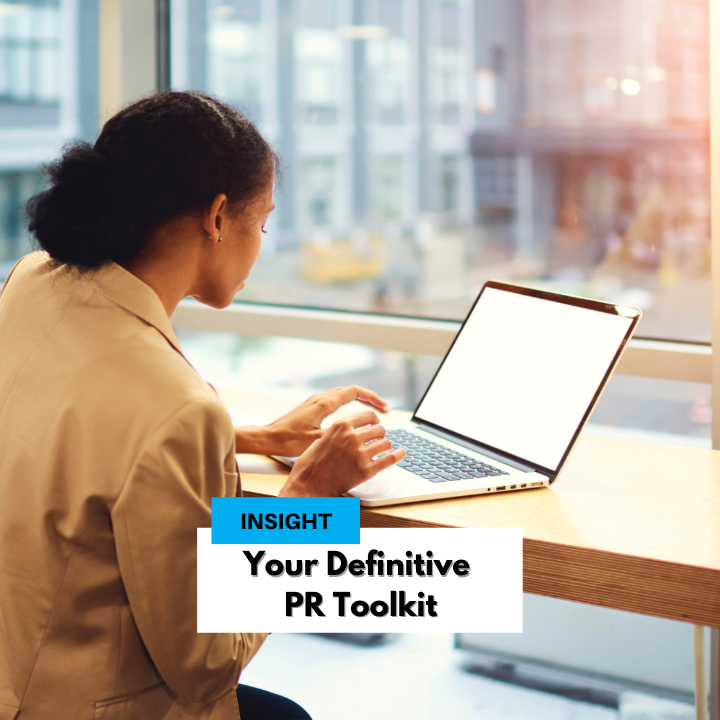Public relations has evolved significantly over the years, even more so during the last 12 months as businesses learn to communicate in new and impactful ways. So, what do today’s marketers and communications professionals need to have in their toolkit? Read on to find out!
A communications strategy and plan
First up, if you don’t have one already, this should be top of your list! Your communications strategy must cover:
- Details of your target market segmentation, including research and insights
- Your budget
- Objectives of your communications activity
- Positioning of your brand
- And a plan!
Essentially, the plan is a calendar of activity which should detail what you are planning to do, which channels you will be using, what resources you already have and those you will need, dates/milestones and the assets required.
Some elements you might include in your communications plan:
- News releases to announce new staff appointments, award wins or new product/service launches – see our own news examples here
- Blog content and articles to keep your audience engaged – again, see our blog archives here
- Email marketing campaign to your audience database
- Website updates/changes
- Whitepapers or reports (particularly if you are a B2B business) providing your audience with valuable content whilst showing your expertise, often available through a data gateway on your website
- Social media activations – daily, weekly and monthly content that you want to share with your following to drive engagement
- Paid campaigns such as Google Advertising
The more detailed your strategy and plan, the better prepared you will be and the more effective your activity will be! The strategy should stay in place for around 12 months but your plan is a living document and as situations change, you can move dates and deadlines, add to or edit actions, and move events or content around as required. Tip – you can find more on the basics of marketing planning in this blog here.
Compelling content
When you’re planning your content, always ask yourself the “so what?” question. Think about why you are writing and sharing this content and, critically, if your audience will be interested! Is it important? How will it affect them? Does it tell them something they will not have read before? What value will it add?
Once you’re confident you’ve got something valuable to share, get creating with your audience front of mind (tip: read this awesome blog on storytelling). No need to limit yourself to written content either:
- Thinking of hosting an event? Read our top tips on virtual events, here.
- Planning on starting a podcast? Learn more about the power of podcasts, here.
- About to start filming a series of content? Check out how to ensure you’re being authentic on camera, here.
- Want to share your news across social media? Get the latest updates, here.
Visual assets
A picture tells a thousand words and video content is so important now. Wyzowl reported that 66% of consumers prefer watching a video to reading about a product! Always film video content when you get the chance and plan video shoots into your campaigns, they really can make the difference between engaging your audience and turning them off.
When it comes to the media, an amazing image can mean the difference between a few lines in the “News in Brief” section or whole page dedicated to you! Great images that tell a story are critical for securing media coverage. And, for online sites and digital platforms, having a video to support your story can mean more people see and listen to your piece, as well as increasing shareability.
If you have the time and resources to organise a product or team photoshoot, do it. If you have a catalogue of fabulous images from your brand’s history, use them. And, if you have a smartphone, you can take your own high quality images and films, right from the comfort of your device! Alternatively, head to Google or Unsplash for rights-free images, or look at paid-for sites like Shutterstock and iStock for more images that will help to tell your story.
Killer media contacts
Always a key part of any PR toolkit – knowing your key media is critical. This could be your local newspapers, industry trade media, regional consumer titles, or the national consumer glossies and newspapers. But how do you let them know you have an awesome story to tell?
Research!
Spend time understanding who you want to talk to and researching who the perfect person is at each title you want to engage with. Smaller and more local publications might only have one or two contacts you can speak to, but the bigger titles will have specialists across a broad range of topics – for example: health and beauty, parenting, politics, tech, automotive, technical gear tests etc…
Once you think you’ve found the right person/people, check out their recent articles to ensure they are a good fit and look at their social channels to see what they’re sharing and how relevant they are. Also keep an eye on when they last posted or published a story – journalists move on and change sector/publication more than you’d expect (particularly with Covid-19 affecting so many journalists), so ensure you have their up to date contact details.
You might also want to consider working with influencers and bloggers to expand your reach. If so, check out our recent blog about how to identify the right influencers for your brand and our top tips for maximising this activity.
Thinking about what’s in your PR toolkit is the first step to giving your business the best chance of success. Using the pointers above will help provide you with some structure and the tips and articles linked throughout will give you some useful tools to help you on your way! Our podcast, Revitalise & Grow, has 14 episodes covering a range of different topics, designed to help you get the most out of your PR activity!
Building on your PR strategy doesn’t need to be complicated or costly, but you need to create and deliver a comprehensive plan because it will have a positive impact on the bottom line of your business. Don’t just download our PR For Small Business guide – actively utilise the tools it offers for your business. We guarantee you’ll see results!






